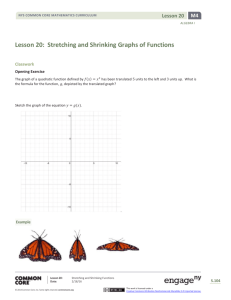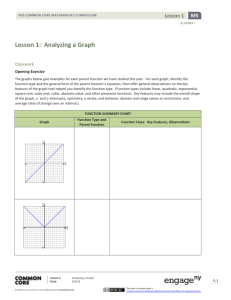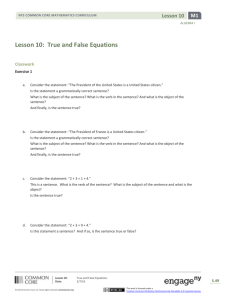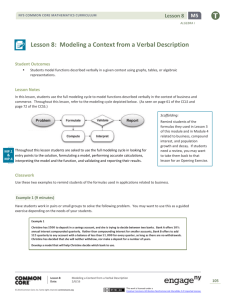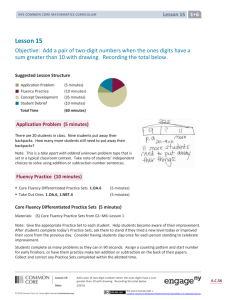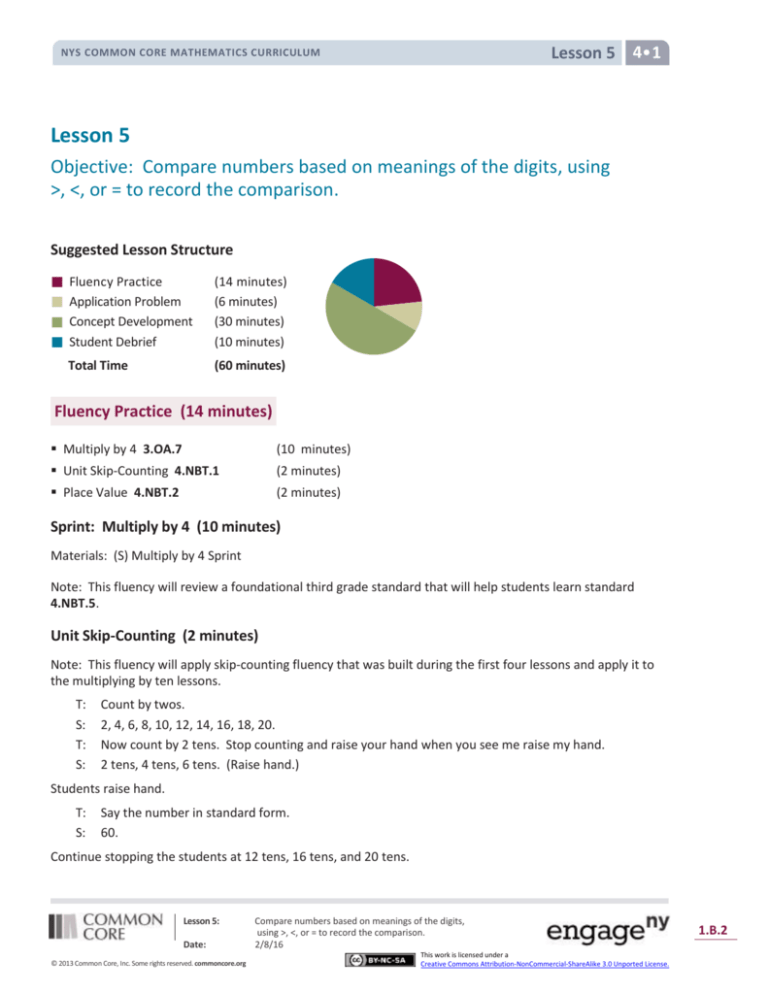
Lesson 5 4
NYS COMMON CORE MATHEMATICS CURRICULUM
Lesson 5
Objective: Compare numbers based on meanings of the digits, using
>, <, or = to record the comparison.
Suggested Lesson Structure
Fluency Practice
Application Problem
Concept Development
Student Debrief
Total Time
(14 minutes)
(6 minutes)
(30 minutes)
(10 minutes)
(60 minutes)
Fluency Practice (14 minutes)
Multiply by 4 3.OA.7
(10 minutes)
Unit Skip-Counting 4.NBT.1
(2 minutes)
Place Value 4.NBT.2
(2 minutes)
Sprint: Multiply by 4 (10 minutes)
Materials: (S) Multiply by 4 Sprint
Note: This fluency will review a foundational third grade standard that will help students learn standard
4.NBT.5.
Unit Skip-Counting (2 minutes)
Note: This fluency will apply skip-counting fluency that was built during the first four lessons and apply it to
the multiplying by ten lessons.
T:
S:
T:
S:
Count by twos.
2, 4, 6, 8, 10, 12, 14, 16, 18, 20.
Now count by 2 tens. Stop counting and raise your hand when you see me raise my hand.
2 tens, 4 tens, 6 tens. (Raise hand.)
Students raise hand.
T:
S:
Say the number in standard form.
60.
Continue stopping the students at 12 tens, 16 tens, and 20 tens.
Lesson 5:
Date:
© 2013 Common Core, Inc. Some rights reserved. commoncore.org
Compare numbers based on meanings of the digits,
using >, <, or = to record the comparison.
2/8/16
This work is licensed under a
Creative Commons Attribution-NonCommercial-ShareAlike 3.0 Unported License.
1.B.2
Lesson 5 4
NYS COMMON CORE MATHEMATICS CURRICULUM
Repeat the process for threes and three ten thousands.
Place Value (2 minutes)
Note: Reviewing and practicing place value skills in isolation will prepare students for success in comparing
numbers during the lesson.
T:
S:
T:
S:
T:
S:
T:
S:
T:
S:
(Write 3,487.) Say the number.
3,487.
What digit is in the tens place?
8.
(Underline 8.) What’s the value of the 8?
80.
State the value of the 3.
3,000.
4?
400.
Repeat for the following possible sequence: 59,607; 287,493; and 7,142,952.
Application Problem (6 minutes)
Draw and label the units on the place value chart. Use each
of the following digits (9, 8, 7, 3, 1, 0) once to create a
number that is between 7 hundred thousand and 9 hundred
thousand. Write the number you created in word form.
Bonus: Create 2 more numbers following the same
directions as above.
Note: This application problem builds on the content of the
previous lesson, requiring students to read and write
multi-digit numbers in expanded, word, and unit forms.
Concept Development (30 minutes)
Materials: (S) Place value boards and markers (or place value
disks)
Problem 1
Comparing two numbers with the same largest unit.
Display: 3,010
2,040
Lesson 5:
Date:
© 2013 Common Core, Inc. Some rights reserved. commoncore.org
Compare numbers based on meanings of the digits,
using >, <, or = to record the comparison.
2/8/16
This work is licensed under a
Creative Commons Attribution-NonCommercial-ShareAlike 3.0 Unported License.
1.B.3
Lesson 5 4
NYS COMMON CORE MATHEMATICS CURRICULUM
T:
S:
T:
S:
T:
S:
T:
S:
T:
S:
Let’s compare two numbers. Say the standard form to your
partner and model each number on your place value board.
NOTES ON
Three thousand, ten. Two thousand, forty.
MULTIPLE MEANS OF
What is the name of the unit with the greatest value?
REPRESENTATION:
Thousands.
Provide sentence frames for students
to refer to when using comparative
Compare the value of the thousands.
statements.
3 thousand is greater than 2 thousand. 2 thousand is less
than 3 thousand.
Tell your partner what would happen if we only compared tens rather than the unit with the
greatest value.
We would say that 2,040 is greater than 3,010 but that isn’t right. The number with more of the
largest unit being compared is greater. We don’t need to compare the tens because the
thousands are different.
Thousands are our largest unit. 3 thousand is greater than 2 thousand so 3,010 is greater than
2,040. (Write the comparison symbol “>" in the circle.) Write this comparison statement on your
board and say it to your partner in two different ways.
3,010 is greater than 2,040 and 2,040 is less than 3,010. (3,010 > 2,040)
Problem 2
Comparing two numbers with an equal amount of the largest units.
Display: 43,021
T:
S:
T:
S:
T:
S:
T:
45,302
Model and read each number. How is this comparison
different from our first comparison?
Before, our largest unit was thousands, now our largest unit is
ten thousands. In this comparison, both numbers have the
same number of ten thousands.
If the digits of the largest unit are equal, how do we compare?
We compare the thousands. We compare the next largest
unit. We compare the digit one place to the right.
Write your comparison statement on your board.
(Students write.) Say the comparison statement in two ways.
43,021 is less than 45,302 and 45,302 is greater than 43,021. (43,021 < 45,302)
Write your own comparison for your partner to solve. Create a comparison in which the largest unit
is the same.
Repeat comparison using 2,305 and 2,530, then 970,461 and 907,641.
Lesson 5:
Date:
© 2013 Common Core, Inc. Some rights reserved. commoncore.org
Compare numbers based on meanings of the digits,
using >, <, or = to record the comparison.
2/8/16
This work is licensed under a
Creative Commons Attribution-NonCommercial-ShareAlike 3.0 Unported License.
1.B.4
Lesson 5 4
NYS COMMON CORE MATHEMATICS CURRICULUM
Problem 3
Comparing values of multiple numbers using a place value chart.
T:
Write the following numbers in your place value chart. Whisper the value of each digit as you do so.
Model these three numbers in your place value chart as numerals.
32,434
T:
MP.1
S:
T:
S:
T:
S:
T:
S:
32,644
32,534
When you compare the value of these three numbers, what do
you notice?
All three numbers have 3 ten thousands. All three numbers
have 2 thousands. We can compare the hundreds because
they are different.
Which number has the greatest value?
32,644.
Tell your partner which number has the least value and how
you know.
32,434 is the smallest of the three numbers because it has the
least number of hundreds.
Arrange the numbers from greatest to least. Use comparison
symbols to express the relationships of the numbers.
32,644 > 32,534 > 32,434
Problem 4
Comparing numbers in different number forms.
Display: Compare 700,000 + 30,000 + 20 + 8 and 735,008
T: Discuss with your partner how to solve this comparison
and write your comparison.
S: I will write the numerals in my place value chart to compare.
Draw disks for each number. I’ll write the first number
in standard form, then compare.
S: 730,028 < 735,008
T: Tell your partner which units you compared and why.
S: I compared thousands because the larger units were the
same. 5 thousands are greater than zero thousands, so
735,008 is greater than 730,028.
NOTES ON
MULTIPLE MEANS FOR
ACTION AND
EXPRESSION:
For students who have difficulty
converting numbers from expanded
form into standard form, demonstrate,
using a place value chart, how each
number can be represented and then
how the numbers can be added
together. Alternatively, use place value
cards to allow students to see the value
of each digit that composes a
number. The cards help students to be
able to manipulate and visually display
the expanded form of a number and
the standard form of a number.
Repeat with 4 hundred thousands, 8 thousands, and 9 tens, and 40,000 + 8,000 + 90.
Lesson 5:
Date:
© 2013 Common Core, Inc. Some rights reserved. commoncore.org
Compare numbers based on meanings of the digits,
using >, <, or = to record the comparison.
2/8/16
This work is licensed under a
Creative Commons Attribution-NonCommercial-ShareAlike 3.0 Unported License.
1.B.5
Lesson 5 4
NYS COMMON CORE MATHEMATICS CURRICULUM
Problem Set (10 minutes)
Students should do their personal best to complete the
Problem Set within the allotted 10 minutes. For some
classes, it may be appropriate to modify the assignment by
specifying which problems they work on first. Some
problems do not specify a method for solving. Students
solve these problems using the RDW approach used for
Application Problems.
Student Debrief (10 minutes)
Lesson Objective: Compare numbers based on meanings
of the digits, using >, <, or = to record the comparison.
Invite students to review their solutions for the Problem
Set and the totality of the lesson experience. They should
check work by comparing answers with a partner before
going over answers as a class. Look for misconceptions or
misunderstandings that can be addressed in the Debrief.
Guide students in a conversation to debrief the Problem
Set. You may choose to use any combination of the
questions below to lead the discussion.
Which is more helpful to you: line up digits or
line up number disks in a place value chart to
compare numbers?
How is comparing numbers in Problem 1(a)
different from Problem 1(b)?
How does your understanding of place value help
to compare and order numbers?
How can ordering numbers apply to real life?
What challenges arise in comparing numbers
when the numbers are written in different forms,
such as in Problem 2?
Exit Ticket (3 minutes)
After the Student Debrief, instruct students to complete
the Exit Ticket. A review of their work will help you assess
the students’ understanding of the concepts that were
presented in the lesson today and plan more effectively
for future lessons. You may read the questions aloud to
the students.
Lesson 5:
Date:
© 2013 Common Core, Inc. Some rights reserved. commoncore.org
Compare numbers based on meanings of the digits,
using >, <, or = to record the comparison.
2/8/16
This work is licensed under a
Creative Commons Attribution-NonCommercial-ShareAlike 3.0 Unported License.
1.B.6
Lesson 5 Sprint 4
NYS COMMON CORE MATHEMATICS CURRICULUM
Lesson 5:
Date:
© 2013 Common Core, Inc. Some rights reserved. commoncore.org
Compare numbers based on meanings of the digits,
using >, <, or = to record the comparison.
2/8/16
This work is licensed under a
Creative Commons Attribution-NonCommercial-ShareAlike 3.0 Unported License.
1.B.7
Lesson 5 Sprint 4
NYS COMMON CORE MATHEMATICS CURRICULUM
Lesson 5:
Date:
© 2013 Common Core, Inc. Some rights reserved. commoncore.org
Compare numbers based on meanings of the digits,
using >, <, or = to record the comparison.
2/8/16
This work is licensed under a
Creative Commons Attribution-NonCommercial-ShareAlike 3.0 Unported License.
1.B.8
Lesson 5 Problem Set 4
NYS COMMON CORE MATHEMATICS CURRICULUM
Name
Date
1. Label the units in the place value chart. Draw place value disks to represent each number in the place
value chart. Use <, >, or = to compare the two numbers. Write the correct symbol in the circle.
a.
600,015
60,015
b.
409,004
440,002
2. Compare the two numbers by using the symbols <, >, and =. Write the correct symbol in the circle.
a. 342,001
94,981
b. 500,000 + 80,000 + 9,000 + 100
five hundred eight thousand, nine hundred one
c. 9 hundred thousands 8 thousands 9 hundreds 3 tens
d. 9 hundreds 5 ten thousands 9 ones
Lesson 5:
Date:
© 2013 Common Core, Inc. Some rights reserved. commoncore.org
908,930
6 ten thousands 5 hundreds 9 ones
Compare numbers based on meanings of the digits,
using >, <, or = to record the comparison.
2/8/16
This work is licensed under a
Creative Commons Attribution-NonCommercial-ShareAlike 3.0 Unported License.
1.B.9
Lesson 5 Problem Set 4
NYS COMMON CORE MATHEMATICS CURRICULUM
3. Use the information in the chart below to list the height in feet of each mountain from least to greatest.
Then name the mountain that has the lowest elevation in feet.
Name of Mountain
Allen Mountain
Mount Marcy
Mount Haystack
Slide Mountain
Elevation in Feet (ft.)
4,347 ft.
5,343 ft.
4,960 ft.
4,180 ft.
4. Arrange these numbers from least to greatest:
8,002
5. Arrange these numbers from greatest to least:
728,000
2,080
820
708,200
2,008 8,200
720,800
87,300
6. One astronomical unit, or 1 AU, is the approximate distance from the earth to the sun. The following are
the approximate distances from earth to nearby stars given in AUs:
Alpha Centauri is 275,725 AUs from earth.
Proxima Centauri is 268,269 AUs from earth.
Epsilon Eridani is 665,282 AUs from earth.
Barnard’s Star is 377,098 AUs from earth.
Sirius is 542,774 AUs from earth.
List the names of the stars and their distances in AUs in order from closest to farthest from earth.
Lesson 5:
Date:
© 2013 Common Core, Inc. Some rights reserved. commoncore.org
Compare numbers based on meanings of the digits,
using >, <, or = to record the comparison.
2/8/16
This work is licensed under a
Creative Commons Attribution-NonCommercial-ShareAlike 3.0 Unported License.
1.B.10
Lesson 5 Exit Ticket 4
NYS COMMON CORE MATHEMATICS CURRICULUM
Name
Date
1. Four friends were playing a game. Use the information in the table below to order the number of points
each player earned from least to greatest. Then name the person who won the game.
Player Name
Amy
Bonnie
Jeff
Rick
Points Earned
2,398 points
2,976 points
2,709 points
2,699 points
2. Use each of the digits 5, 4, 3, 2, 1 exactly once to create two different five-digit numbers.
a. Write each number on the line and compare the two numbers by using the symbols < or >.
Write the correct symbol in the circle.
__________________
__________________
b. Use words to write a comparison statement for the problem above.
Lesson 5:
Date:
© 2013 Common Core, Inc. Some rights reserved. commoncore.org
Compare numbers based on meanings of the digits,
using >, <, or = to record the comparison.
2/8/16
This work is licensed under a
Creative Commons Attribution-NonCommercial-ShareAlike 3.0 Unported License.
1.B.11
Lesson 5 Homework 4
NYS COMMON CORE MATHEMATICS CURRICULUM
Name
Date
1. Label the units in the place value chart. Draw place value disks to represent each number in the place
value chart. Use <, >, or = to compare the two numbers. Write the correct symbol in the circle.
a.
909,013
b.
210,005
90,013
220,005
2. Compare the two numbers by using the symbols <, >, and =. Write the correct symbol in the circle.
a. 501,107
89,171
b. 300,000 + 50,000 + 1,000 + 800
six hundred five thousand, nine hundred eight
c. 3 hundred thousands 3 thousands 8 hundreds 4 tens
d. 5 hundreds 6 ten thousands 2 ones
Lesson 5:
Date:
© 2013 Common Core, Inc. Some rights reserved. commoncore.org
303,840
3 ten thousands 5 hundreds 1 one
Compare numbers based on meanings of the digits,
using >, <, or = to record the comparison.
2/8/16
This work is licensed under a
Creative Commons Attribution-NonCommercial-ShareAlike 3.0 Unported License.
1.B.12
Lesson 5 Homework 4
NYS COMMON CORE MATHEMATICS CURRICULUM
3. Use the information in the chart below to list the height in feet of each skyscraper from least to greatest.
Then name the tallest skyscraper.
Name of Skyscraper
Willis Tower
Freedom Tower
Taipei 101
Petronas Towers
Height of Skyscraper (ft.)
1,450
1,776
1,670
1,483
4. Arrange these numbers from least to greatest:
7,550
5. Arrange these numbers from greatest to least:
426,000
5,070
750
406,200
5,007 7,505
640,020
46,600
6. The area of the 50 states can be measured in square miles (sq. miles).
California is 158,648 sq. miles. Nevada is 110,567 sq. miles. Arizona is 114,007 sq. miles.
Texas is 266,874 sq. miles. Montana is 147,047 sq. miles, and Alaska is 587,878 sq. miles.
Arrange the states listed by area from least to greatest.
Lesson 5:
Date:
© 2013 Common Core, Inc. Some rights reserved. commoncore.org
Compare numbers based on meanings of the digits,
using >, <, or = to record the comparison.
2/8/16
This work is licensed under a
Creative Commons Attribution-NonCommercial-ShareAlike 3.0 Unported License.
1.B.13



